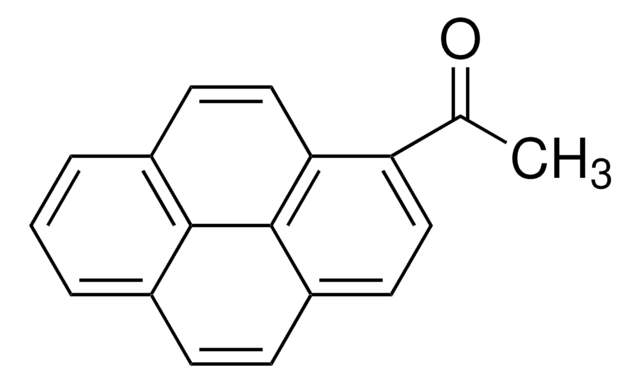392189
1-Pyreneacetic acid
97%
Synonym(s):
(1-Pyrenyl)acetic acid
Sign Into View Organizational & Contract Pricing
All Photos(1)
About This Item
Empirical Formula (Hill Notation):
C18H12O2
CAS Number:
Molecular Weight:
260.29
MDL number:
UNSPSC Code:
12352100
PubChem Substance ID:
NACRES:
NA.22
Recommended Products
Assay
97%
form
solid
mp
210-212 °C (dec.) (lit.)
SMILES string
OC(=O)Cc1ccc2ccc3cccc4ccc1c2c34
InChI
1S/C18H12O2/c19-16(20)10-14-7-6-13-5-4-11-2-1-3-12-8-9-15(14)18(13)17(11)12/h1-9H,10H2,(H,19,20)
InChI key
SDJCLYBBPUHKCD-UHFFFAOYSA-N
Related Categories
General description
1-Pyreneacetic acid is a negatively charged pyrene derivative. It has been proposed as titrating reagent for the standardization titration of Grignard reagents and n-butyl lithium (n-BuLi).
Application
1-Pyreneacetic acid is suitable for use in the following studies:
- Synthesis of N-(2-(methylthio)ethyl)-2-(pyren-1-yl)acetamide, a pyrene amide based Pd2+ probe.
- Synthesis of pyrene-modified β-cyclodextrin.
- To functionalize single walled carbon nanotube field effect transistors (CNT FETs).
- As an agent for characterizing grafting degrees and reactivity of the ester functionalized polypropylenes.
- Synthesis sawhorse-type diruthenium tetracarbonyl complexes.
- Synthesis of (±)-2-(1-pyrenyl)propionic acid, a chiral carboxylic acid.
- Reversible noncovalent functionalization of single walled carbon nanotubes (SWNTs).
- Preparation of peptide nucleic acid (PNA) probes.
- As an internal reference compound in the assessment of solid phase reaction by HPLC-UV.
Storage Class Code
11 - Combustible Solids
WGK
WGK 3
Flash Point(F)
Not applicable
Flash Point(C)
Not applicable
Personal Protective Equipment
dust mask type N95 (US), Eyeshields, Gloves
Certificates of Analysis (COA)
Search for Certificates of Analysis (COA) by entering the products Lot/Batch Number. Lot and Batch Numbers can be found on a product’s label following the words ‘Lot’ or ‘Batch’.
Already Own This Product?
Find documentation for the products that you have recently purchased in the Document Library.
Customers Also Viewed
Kadish KM, et al.
Handbook of Porphyrin Science: With Applications to Chemistry, Physics, Materials Science, Engineering, Biology and Medicine, Volumes 1-5, 1-5, 107-107 (2010)
Mitchell B Lerner et al.
Journal of the American Chemical Society, 134(35), 14318-14321 (2012-08-17)
Despite the great promise of carbon nanotube field-effect transistors (CNT FETs) for applications in chemical and biochemical detection, a quantitative understanding of sensor responses is lacking. To explore the role of electrostatics in sensor transduction, experiments were conducted with a
Rappoport Z and Marek I.
The Chemistry of Organomagnesium Compounds, 288-288 (2008)
Ester functionalization of polypropylene via controlled decomposition of benzoyl peroxide during solid-state shear pulverization.
Diop MF and Torkelson JM.
Macromolecules, 46(19), 7834-7844 (2013)
Thioether Amide Based-Fluorescent Chemosensors for Pd2+ with High Selectivity over Pd 0.
Ahn SY, et al.
Bull. Korean Chem. Soc., 35(7), 2189-2189 (2014)
Our team of scientists has experience in all areas of research including Life Science, Material Science, Chemical Synthesis, Chromatography, Analytical and many others.
Contact Technical Service












